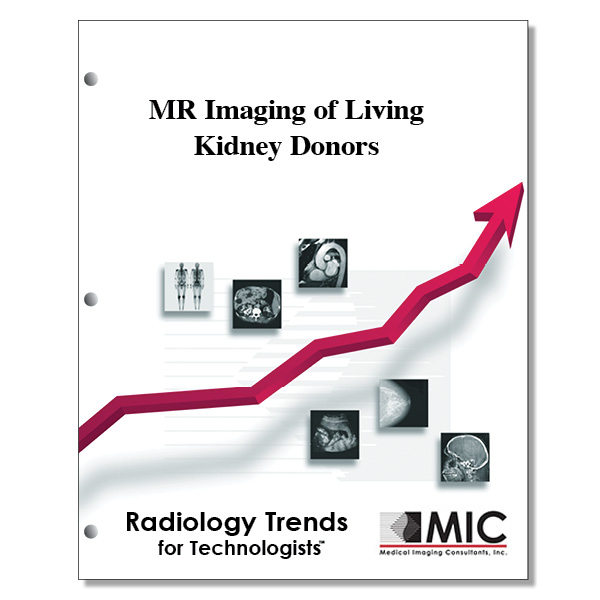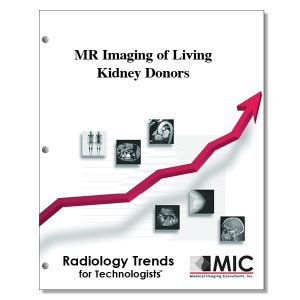

MR Imaging of Living Kidney Donors
An overview of how MRI can be used as a one-stop-shop for evaluating potential living kidney donors.
Course ID: Q00078 Category: Radiology Trends for Technologists Modalities: MRI, Nuclear Medicine2.25 |
Satisfaction Guarantee |
$24.00
- Targeted CE
- Outlne
- Objectives
Targeted CE per ARRT’s Discipline, Category, and Subcategory classification for enrollments starting after June 11, 2024:
[Note: Discipline-specific Targeted CE credits may be less than the total Category A credits approved for this course.]
Computed Tomography: 0.50
Procedures: 0.50
Abdomen and Pelvis: 0.50
Magnetic Resonance Imaging: 1.25
Image Production: 0.50
Sequence Parameters and Options: 0.25
Data Acquisition, Processing, and Storage: 0.25
Procedures: 0.75
Body: 0.75
Nuclear Medicine Technology: 0.50
Procedures: 0.50
Gastrointestinal and Genitourinary Procedures: 0.50
Radiography: 0.50
Procedures: 0.50
Thorax and Abdomen Procedures: 0.50
Registered Radiologist Assistant: 1.00
Procedures: 1.00
Abdominal Section: 1.00
Sonography: 0.50
Procedures: 0.50
Abdomen: 0.50
Radiation Therapy: 1.00
Patient Care: 0.50
Patient and Medical Record Management: 0.50
Procedures: 0.50
Treatment Sites and Tumors: 0.50
Vascular-Interventional Radiography: 0.50
Procedures: 0.50
Vascular Diagnostic Procedures: 0.50
Vascular Sonography: 0.50
Procedures: 0.50
Abdominal/Pelvic Vasculature: 0.50
Outline
- Introduction
- MR Imaging Technique
- Postprocessing of 3D Data Sets
- MR Imaging Findings versus Those of Other Imaging Modalities
- Discussion and Conclusions
Objectives
Upon completion of this course, students will:
- know the rate at which end-stage renal disease is increasing
- list the benefits of living donor transplantation
- list the benefits of laparoscopic nephrectomy
- understand the conditions which may require an open nephrectomy
- know which renal exams can and cannot be replaced by MRI
- understand what a preoperative MRI exam should evaluate
- know in which planes T2-weighted FSE or SSFSE images should be acquired
- understand the benefits of coronal T2 imaging
- know the best plane to demonstrate the relationship of the kidneys to the liver and spleen
- understand how to use axial T2 imaging
- understand what technical factors should be minimized to limit background signal in a renal MR arteriogram
- be familiar with the use of coronal fast GRE in a comprehensive renal donor protocol
- understand why post contrast axial fast GRE is done
- know the parameters used to calculate the imaging delay
- be familiar with parameter selection when planning Coronal fast GRE venogram
- understand why to modify the coronal fast GRE for venous anatomy vs arterial anatomy
- understand which imaging matrix is preferred
- know the placement of the coronal fast GRE relative to the vascular anatomy
- understand the post processing of 3D CEMRA of the renal arteries/veins
- understand the use of targeted MIP
- be familiar with the effect of anisotropy, pulsation, and peristalsis on reformatted images
- know which types of reformatted images are not commonly used to evaluate renal vasculature
- be familiar with vascular anomalies found in renal donor candidates
- know the prevalence of multiple renal arteries
- know what percentage of kidneys have two or more arteries
- know what flip angles are used in abdominal MRA (arterial) sequences
- understand the prevalence of multiple renal arteries compared to that of multiple renal veins
- know what the most common variant of the left renal vein is
- be familiar with renal vasculature
- be familiar with renal vascular anomalies
- be familiar with renal parenchymal abnormalities in living donors
- understand why MRI is preferable for healthy donor work-up
- know the best MRA technique for renal veins
- understand the conditions for which MRI is effective
- know the accuracy of MR and CT in the evaluation of the main renal arteries and larger accessory arteries.
